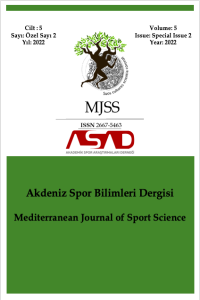Futbolda Üç Puan Kuralı, Gol Sayısı ve Öngörülebilirlik: Markov-Rejim Değişim Modeli ile Uzun Dönemli Bir Analiz
Öz
Bu araştırmada Markov-Rejim Değişim Modeli yaklaşımı kullanılarak futbolda üç puan kuralı uygulamasının atılan gol sayısı ve maçların öngörülebilirliği üzerindeki etkileri incelenmiştir. Türkiye Birinci Futbol Ligi örneğinde 61 sezonu ve üç takımı kapsayan analizde elde edilen sonuçlar beklendiği gibi üç puan kuralının maçlardaki gol sayısını arttırdığını göstermiştir. Ancak üç puan kuralının maçların öngörülebilirliği üzerindeki etkileri her takım içi farklıdır.
Anahtar Kelimeler
Futbol Üç Puan Kuralı Öngörülebilirlik Football Three-Point Rule Predictability
Kaynakça
- Alfano, V., Cicatiello, L., Gaeta, G. L., Gallo, M., & Rotondo, F. (2021). Three is a magic number: Evidence on the effects of the application of the three-point rule in Italy’s Serie A. Journal of Sports Economics, 22(3), 329-356.
- Aylott, M., & Aylott, N. (2007). A meeting of social science and football: Measuring the effects of three points for a win. Sport in Society: Cultures, Commerce, Media, Politics, 10, 205-222.
- Brook, S. (2005). What do sports teams produce? Journal of Economic Issues, 39(3), 792-797.
- Dilger, A., & Geyer, H. (2009). Are three points for a win really better than two? A comparison of German soccer league and cup games. Journal of Sports Economics, 10, 305-318.
- Gaviria, A. (2000). Is soccer dying? A time series approach. Applied Economics Letters, 7(4), 275-278.
- Guedes, J. C., & Machado, F. S. (2002). Changing rewards in contests: Has the three-point rule brought more offense to soccer? Empirical Economics, 27, 607-630.
- Hamilton, J. D. (1989). A new approach to the economic analysis of nonstationary time series and the business cycle. Econometrica 57(2), 357-384.
- Haugen, K. K. (2008). Point score systems and competitive imbalance in professional soccer. Journal of Sports Economics, 9, 91-210.
- Lee, Y. H., & Parinduri, R. (2016). Does the three-point rule make soccer more exciting? Evidence from a regression discontinuity design. Journal of Sports Economics 17(4), 377-395.
- Moschini, G. (2010). Incentives and outcomes in a strategic setting: The 3-points-for-a-win system in soccer. Economic Inquiry, 48, 65-79.
- Palacious-Huerta, I. (2004). Structural breaks during a century of the world’s most popular sport. Statistical Methods and Applications, 13, 241-258.
- Psaradakis, Z., & Spagnolo, N. (2003). On the determination of the number of regimes in Markov-switching autoregressive models. Journal of Time Series Analysis, 24(2), 237-252.
- Varela-Quintana, C., Del Corral, J., & Prieto-Rodriguez, J. (2018). Home-team response to the three-point victory rule: New evidence using double and triple differences. International Journal of Sport Finance, 13(4), 353 -372.
Three-Point Rule, Average Goals Per Game and Predictability in Football: A Long-Term Analysis with The Markov-Regime Switching Approach
Öz
In this study, the effects of the three-point rule in football on the average goals per game and the predictability of the matches were investigated by using the Markov-Regime Switching Model. The results obtained in the analysis covering 61 seasons and 3 teams in the example of the Turkish First Division Football League showed that the three-point rule increased the average goals per game, as expected. However, the effects of the three-point rule on the predictability of matches are different for each team.
Anahtar Kelimeler
Kaynakça
- Alfano, V., Cicatiello, L., Gaeta, G. L., Gallo, M., & Rotondo, F. (2021). Three is a magic number: Evidence on the effects of the application of the three-point rule in Italy’s Serie A. Journal of Sports Economics, 22(3), 329-356.
- Aylott, M., & Aylott, N. (2007). A meeting of social science and football: Measuring the effects of three points for a win. Sport in Society: Cultures, Commerce, Media, Politics, 10, 205-222.
- Brook, S. (2005). What do sports teams produce? Journal of Economic Issues, 39(3), 792-797.
- Dilger, A., & Geyer, H. (2009). Are three points for a win really better than two? A comparison of German soccer league and cup games. Journal of Sports Economics, 10, 305-318.
- Gaviria, A. (2000). Is soccer dying? A time series approach. Applied Economics Letters, 7(4), 275-278.
- Guedes, J. C., & Machado, F. S. (2002). Changing rewards in contests: Has the three-point rule brought more offense to soccer? Empirical Economics, 27, 607-630.
- Hamilton, J. D. (1989). A new approach to the economic analysis of nonstationary time series and the business cycle. Econometrica 57(2), 357-384.
- Haugen, K. K. (2008). Point score systems and competitive imbalance in professional soccer. Journal of Sports Economics, 9, 91-210.
- Lee, Y. H., & Parinduri, R. (2016). Does the three-point rule make soccer more exciting? Evidence from a regression discontinuity design. Journal of Sports Economics 17(4), 377-395.
- Moschini, G. (2010). Incentives and outcomes in a strategic setting: The 3-points-for-a-win system in soccer. Economic Inquiry, 48, 65-79.
- Palacious-Huerta, I. (2004). Structural breaks during a century of the world’s most popular sport. Statistical Methods and Applications, 13, 241-258.
- Psaradakis, Z., & Spagnolo, N. (2003). On the determination of the number of regimes in Markov-switching autoregressive models. Journal of Time Series Analysis, 24(2), 237-252.
- Varela-Quintana, C., Del Corral, J., & Prieto-Rodriguez, J. (2018). Home-team response to the three-point victory rule: New evidence using double and triple differences. International Journal of Sport Finance, 13(4), 353 -372.
Ayrıntılar
| Birincil Dil | İngilizce |
|---|---|
| Konular | Egzersiz ve Spor Bilimleri |
| Bölüm | Arşiv |
| Yazarlar | |
| Yayımlanma Tarihi | 23 Aralık 2022 |
| Gönderilme Tarihi | 24 Kasım 2022 |
| Kabul Tarihi | 16 Aralık 2022 |
| Yayımlandığı Sayı | Yıl 2022 Cilt: 5 Sayı: Özel Sayı 2 - Akademik Spor Araştırmaları Özel Sayısı |
Cited By
The effects of rule changes in football-code team sports: a systematic review
Science and Medicine in Football
https://doi.org/10.1080/24733938.2024.2375752
Mediterranean Journal of Sport Science (MJSS) is licensed under a Creative Commons Attribution 4.0 International License CC BY-NC 4.0 .


